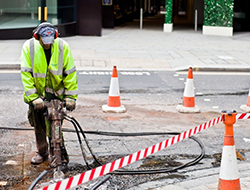There are risks present in almost any workplace, but they’re especially common in industrial settings and building sites. Risk assessments are there to help you to decide how you can ensure the health and safety of employees by negating the specific risks of the workplace.
In workplaces where vibrating machinery is used, particularly construction sites, risk assessments tailored specifically towards hazards posed by vibrations can be carried out. The findings of a risk assessment must be recorded, and an action plan should be made:
A vibration risk assessment should:
• Identify the risk from vibration and determine who may be affected
• Contain an estimate of the employees’ risk of exposure
• Identify how you can comply with health and safety laws
• Identify employees who are at risk and provide them with extra guidance
Hand-arm vibration syndrome (HAVS)
Hand-arm vibration syndrome, also known as HAVS, is a serious and disabling condition that could be potentially costly to your business. It is also easily avoidable through preventative measures.
Around 5 million people are exposed to HAVS at work, with the greatest risk being to those working in the construction industry. There are especially high levels of exposure in heavy fabrication, foundry fettlers, and stonemasons.
Employers have a duty of care to their employees, to ensure that health and safety advice is followed in the workplace. A full risk assessment should be undertaken, with a hierarchy of measures to achieve control over the risk. As part of this, information, instruction and training for employees should be made available, with health surveillance should be provided if required.
Level of exposure
Employers are duty-bound to eliminate vibration risk at its source or reduce it to the lowest reasonably practicable level. Employees should not be exposed above the Exposure Limit Value, and if they are, immediate action should be taken to prevent a recurrence.
Exposure Action Value (EAV) is 1.5 m/s squared A(8). This is lower than the old HSE recommended action level, which is not a safe level of exposure.
Exposure Limit Value (ELV) 5m/s squared A(8) - higher than the old HSE recommended action level, which means it could be a challenge for some sectors but it will prevent the worst risks.
Completing a HAVS risk assessment
When completing a risk assessment, look for evidence of the risk:
• Does the industry use processes or tools with a known HAVS risk?
• Is there a significant daily operating time?
• Are there HAVS symptoms in the workforce?
• Does anyone experience tingling after tool use?
Look for solutions:
• Is good practice being applied?
• Does everyone understand how to combat the risk?
• Can more be done?
Think about whether the exposure is likely to be above the action value. If this is the case, create an action plan to reduce exposure and start health surveillance. Is the exposure above the limit value?
Be sure to seek out vibration information from equipment manufacturers, other sources of relevant data and workplace measurements to ensure that workers are always protected.
Controlling HAVS exposure
To control the risk of HAVS exposure and injury, there are ways to prevent and minimise the risk. It may even be the case that you need to change the damaging process to eliminate or reduce the risk completely. For example, job rotation could be added to shift patterns to minimise exposure time.
Suitable equipment can reduce the risk of vibration, so PPE like gloves, ear protectors and protective boots are all necessary. Workers should be trained in wearing them and how to maintain their PPE properly.





Leave a comment